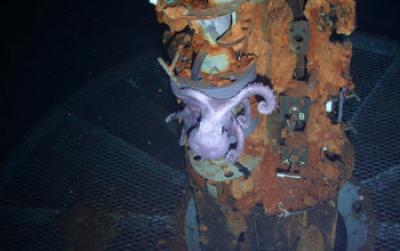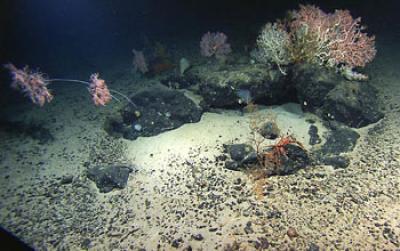"Who in his wildest dreams could have imagined that, beneath the crust of our Earth, there could exist a real ocean...a sea that has given shelter to species unknown?"
So wrote Jules Verne almost 150 years ago in A Journey to the Center of the Earth. Verne probably couldn't have imagined the diversity of life that researchers observe today under the ocean floor.
Scientists affiliated with the National Science Foundation (NSF) Center for Dark Energy Biosphere Investigations (C-DEBI) will discuss recent progress in understanding life beneath the seafloor at the American Geophysical Union (AGU) fall meeting, held in San Francisco from Dec. 3-7, 2012.
Once considered a barren plain dotted with hydrothermal vents, the seafloor and the crust beneath it are humming with microbial life--with "dark energy," says Katrina Edwards of the University of Southern California, director of C-DEBI.
Seafloor and subseafloor bacteria not only exist, they're more abundant and diverse than previously thought. The bacteria "feed" on the planet's oceanic crust, posing questions about ocean chemistry and the co-evolution of Earth and life.
"We now know that this remote region is teeming with microbes, more so than anyone guessed," says David Garrison, program director in NSF's Division of Ocean Sciences, which funds C-DEBI.
While scientists have estimated that microbes living in deep ocean sediments may represent as much as one-third of Earth's total biomass, the habitable part of the ocean crust may be ten times as great.

Scientists have found that rocks beneath the seafloor are teeming with microbial life.
(Photo Credit: Nicolle Rager-Fuller/National Science Foundation)
Dark environments appeared to offer little energy for sustaining life. But the abundance of microbes in the subseafloor causes scientists to wonder how long life may have thrived there.
Researchers are working to answer such questions as:
- What is the nature of subseafloor microbial communities, and what is their role in the alteration of young ocean crust?
- Are these communities unique, especially in comparison with seafloor and sedimentary communities?
- Where do microbes in the ocean crust come from--sediment, rock, seawater or another source?

"Dark energy" is found in ocean depths: life abounds above and below the seafloor.
(Photo Credit: WHOI)

Rocks made of basalt on and under the ocean bottom harbor abundant deep-sea bacteria.
(Photo Credit: NOAA/WHOI)
Source: National Science Foundation